#and my friends finally got me to download marvel rivals to play with them
Explore tagged Tumblr posts
Text
I saw a poem by Lyra Wren the other day about falling in love and it immediately reminded me of how I view Shinji falling for someone-more specifically in Moonlight Serenade-and it's got me motivated to continue my wip that I have for him of his POV throughout the fic.
But here's my dilemma; I finally got CFYOW the other week and have been reading through it. I'm currently halfway through the second volume (yay!) and I want to keep reading it to know more about the Bleach universe/lore and to officially say that I'm caught up.
But now I want to write too 😭 so many things to do, so little time to do them...
#sopra speaks#i also want to play hello kitty island adventure since that came out on the switch now#and my friends finally got me to download marvel rivals to play with them#and there's about to be a rewards event in the sims 4#if only i had enough of me to do everything all at once#sigh
9 notes
·
View notes
Text
Weekend Top Ten #454
Top Ten Launch Games
Oooh, it’s finally here!
By the time you read this, the Xbox Series X/S consoles will be out, and the PlayStation 5 will be imminent if not already with us. At the time of writing I’ve yet to sample either console, although hopefully that will soon change. However, it’s a bit of a weird console launch, especially for Xbox owners, as there’s not much in the way of actual launch titles. PlayStation has the excellent-looking technical showcase (in that it shows off their sexy new controller, if not necessarily the excesses of the console’s visual prowess) Astro’s Playroom. But on the Xbox side, the only genuine first-party exclusive (not including the port of rather smashing PC title Gears Tactics) was to be the troubled Halo Infinite, which has now been pushed to next year to deal with some of its apparent graphical deficiencies. For what it’s worth, as a Halo fan, I thought the actual gameplay presented looked as good as it always has, so I’m still very excited, but it’s a shame not to sample something genuinely new and shiny at launch. For me, then – as someone not getting a PlayStation this year – I’m going to have to contend myself with updated versions of older games, and hopefully something like the really exciting-looking The Falconeer or, eventually, Cyberpunk 2077.
Of course, it’s not always been like this; in the past, a landmark game has often been the core reason to upgrade to a new console. Certain titles have defined their hardware platforms, offering a taste of the experiences to come, be it through revolutionary control systems, previously-unimaginable graphics, or simply by shattering preconceptions and expectations. As such, this weekend I’m celebrating my favourite launch titles.
Now, a couple of my usual caveats. I’ve hardly owned any consoles in the grand scheme of things; I was a computer gamer until the launch of the first Xbox, and even then was PC-first until about midway through the 360’s life. As such I came to a lot of these late, or played them on friends’ systems. I’m sure a videogame historian would give you another list, one that was able to put each title into its historical perspective. For my part, I’m mostly basing it on how much I like the game, but I am also trying to weight it in terms of its “importance”. I mean, one of my favourite “launch titles” of all time would be Lego Marvel Super Heroes on the Xbox One/PS4, but that seems a bit of a ridiculous game to call a launch title, especially as it doesn’t really show off the hardware or define the generation in any particular way. I just think it rocks. So I’m trying to judge it also in terms of how effective a given game was at being a launch title, as well as my personal preference; as such, some games, which I think are more emblematic of their time or their hardware, might end up higher in the list than if I was otherwise just ranking my favourites.
Christ, that was boring. Look, here are ten games that I like that came out when a console came out. Have at it.

Halo: Combat Evolved (Xbox, 2001): it’s not just that it made playing an FPS on a console as comfortable and enjoyable as on PC, but it revolutionised what an FPS could do. Expansive open landscapes, dynamic combat with intelligent enemies, an ingenious shield/health combo, two weapons, drivable vehicles, and frankly outstanding graphics. And for Xbox – a curious underdog, a big black sheep devoid of cool or class and feeling like Microsoft was trying to buy its way into the console space with a hefty dose of brute force – here was something unique, something incredible. I don’t think anyone quite expected Halo, and it’s arguable that it single-handedly changed not only Microsoft and Xbox’s fortunes but the entire game industry too.
Wii Sports (Wii, 2005): the Wii was this strange outlier, a tiny white box that eschewed the grunt and girth of its rivals, and seemingly built around its unique motion controller. Would it work? Wii Sports proved that yes it would, a delightful bundle of games that perfectly showed what the console and controller could do. Immense fun in and of itself, but the Wii’s ability to lower the barrier of entry to non-gamers meant that your dad could thrash your brother at bowling. And that is a thing to cherish forever.
Tetris (GameBoy, 1989): depending on where you look, Tetris may just be the best-selling game of all time. It’s on everything now, from the Xbox Series X to your watch. But there was a time when “Tetris” meant “GameBoy”; that four-colour greenscreen box of wonder that everybody had but me. It was beyond ubiquitous, and its short-form nature and simplistic styling made it ideal for the portable console, its chirpy and iconic music sounding perfect coming from those tiny speakers. And above all else, of course, Tetris is fantastic, one of the greatest games of all time. It was a perfect marriage of software and hardware.
The Legend of Zelda: Breath of the Wild (Switch, 2017): so here’s the thing: I like Zelda, but I’ve never fallen in love with it. I didn’t grow up with it, so coming to Ocarina of Time, there were too many old-fashioned trappings in the way; it just didn’t feel as enthralling or as fun to play as, say, Half-Life or Deus Ex. BOTW changed that; the limitations were gone, the world was blown wide open. It no longer felt like an 80s game in three dimensions, it felt new. Better than new – it felt like tomorrow. Despite the Switch being graphically weaker than its contemporaries, BOTW was and is simply gorgeous to look at, but it’s how it plays, how it feels like a vast but real world, how it has its own rules and they make sense instantly. It’s the greatest open world game of all time, and emergent physics sandbox, and yet it’s still unquestionably Zelda, emphatically Nintendo. Okay, it technically came out on the Wii U at the same time, but who the hell played that? This was the game that made you want a Switch.
Super Mario 64 (N64, 1997): this is often the game people cite as being one of the great revolutionary launch titles, but I must confess its charms were lost to me at first. Taking what was great about Mario and converting it expertly into 3D was a heck of a feat; graphically for the time it certainly impressed in the scale of its worlds, and whilst back then I felt it lacked the detail and granularity of some PC titles, in retrospect it was a perfectly-suited art style, offering smooth textures even when right up close. But it was its precise controls and the open, hub-based nature of its worlds that was revolutionary; many games aped its style, but it took a long time before anything really matched it.
Hexic HD (Xbox 360, 2005): not every game here has to be some genre-busting graphical powerhouse; they can be simple but quietly revolutionary. Hexic HD is a terrific puzzle game with a simple hook, brilliantly executed, and enough intrigue and nuance to keep you coming back for one more go, to beat your high score, to get to the next tricksy level. But the time and manner of its release, and what that signified, marked it out as something more important. It was the first Xbox Live Arcade title; Microsoft’s curated gallery of smaller, more indie-flavoured games. More than that, it was free, coming pre-installed on all Xbox 360 Pros (the ones with the removable hard drive). It was a taste of what was to come, introducing audiences not only to the idea of playing these kinds of smaller, less intense games on a console, but also the idea of purchasing and downloading them digitally. It was great and ground-breaking in equal measure.
WipEout (PlayStation, 1995): I kinda missed the PlayStation generation. I was still, more or less, in my PC-centric “consoles are toys” mindset (which I wouldn’t fully shake off till the release of the N64). But I came to appreciate its qualities as a cool, exciting, super-fast futuristic racer. I’m pretty sure it’s not the first 3D hover-car racing game, but it was presented in such a groovy package that it ticket all the boxes, and helped show off just what the PlayStation was capable of in terms of its 3D graphics and CD sound. And, of course, it helped define the console as being a bit more edgy and grown-up than the previous Nintendo and Sega stalwarts.
Super Mario Bros. (NES, 1988): what can be said about one of the most iconic games of all time? Mario Bros defined not only a console, not only a generation, but arguably an entire artform. Creating what we now know as a platform game, it expanded and surpassed the basic template of Donkey Kong into a roaming adventure, part twitch-gaming reaction test, part puzzle game. I played a lot of copycat games on my Amiga, but even then, as a whiny computer brat, I knew that Mario was better. Even when my cousins got a MegaDrive and Sonic, I knew – deep in my heart – that Mario was better. It's a deep game, an endlessly replayable game, a supremely fair game despite its difficulty. I think it’s hard to overstate just how good, or how influential, Mario was.
Project Gotham Racing (Xbox, 2001): I tried hard to pick a different platform for every game in this list, but I couldn’t exclude PGR. This may be tied up with my biography a little bit, but my other half and I played this game to death. I never think of myself as a big racer fan, but every once in a while a title comes out that I just really, really get into – Jaguar XJ220 on the Amiga, Midtown Madness on PC, the Forza Horizon series nowadays – and PGR did that in spades. A gorgeous arcade racer, it was a great launch title to show off the sheer grunt of the Xbox; then, as now, the most powerful console on the market. It also offered a terrific four-player split-screen. But its Kudos feature – borrowed from semi-prequel Metropolis Street Racer – offered ways to win outside of sheer racing graft, awarding cool driving. I still love the original, and I kinda wish they’d bring back or reimagine its city-based driving for a future release or Forza spin-off.
Lumines: Puzzle Fusion (PSP, 2004): okay, so this is a bit of a cheat as I've barely played the original PSP version, but Lumines is just phenomenal; the best moving-blocks-around game since Tetris, and probably the most influential one since then too (for the record, I've played it extensively on multiple other platforms). An excellent spin on a Tetris-a-like, its use of music and colour made it a beautiful, brilliant sensory experience. With Sony entering the handheld market, the PSP needed a USP, something vibrant and cool that suited a portable experience, and Lumines provided it in spades; also its funky visuals and music was a good fit for Sony’s brand.
Well, that was fun, and a lot harder than I expected. If you’re enjoying a new console this Christmas, then hopefully you’ll have fun with one of the new launch titles too – even if I doubt any (apart from maybe Astro) would trouble a list like this in the future (although I do think The Falconeer looks all kinds of cool).
#top ten#games#gaming#launch games#xbox series x#xbox series s#playstation 5#nintendo#switch#halo#mario#zelda
1 note
·
View note
Text
Sega Dreamcast
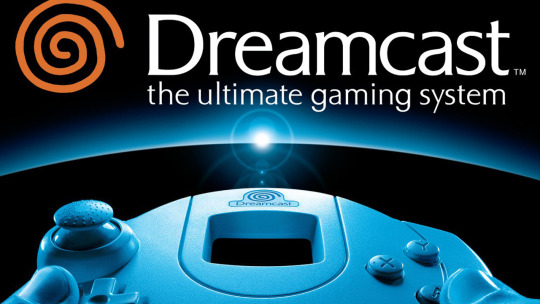
I hated middle school. There’s a whole swath of memories I’d rather do without as far as the years 1999 through 2002 are concerned. There is, however, one memory I hold near and dear to my heart during this time frame. After reading about it in magazines and being really excited for it, my mother took me to Toys’R’Us one evening to get me a Sega Dreamcast. We brought that puppy home with a copy of Sonic Adventure, hooked it up, fired it up, and took it all in. As the opening cinematic played on my TV, Mum said “It’s like playing a movie!”
Boy, if we only knew what games would go on to look like now.
The Dreamcast was, and to this day remains, my all time favorite console. It’s the swan song of a company that was perhaps a bit too ambitious for its own good, a marvel of gaming technology many years ahead of its time, and home to some of the best and most unique games to ever come out.
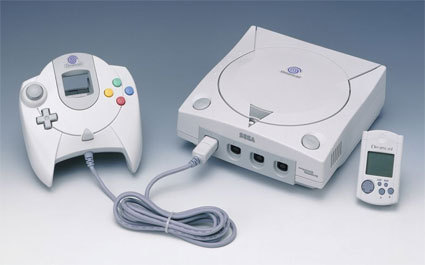
At the time of its release, the Dreamcast was the most graphically powerful console on the market. Sony’s Playstation boasted 32-bit graphics, and the Nintendo 64 had double that, at -wait for it- 64 bits. Dreamcast had double of that: 128 bits of beautiful graphics, thanks to the GD-ROM, a proprietary disc format born from squeezing every bit of memory out of a regular old CD as was physically possible, before DVDs and Blu-Ray became as ubiquitous as they are today.
Even the method of memory storage was unlike its competitors; the standard memory card for the Dreamcast was the Visual Memory Unit (VMU), a cross between a memory card and a Gameboy that let you manage data and download minigames to extend the functionality of many games. The only other thing like it that I can think of being made is Sony’s Pocketstation, and that never saw the light of day outside of Japan. You would not believe the number of button-cell batteries I burned through caring for Chao on the go.
Of course, all of the fancy tech and cool gadgets wouldn’t amount to much if the games on offer weren’t fun at all. Tiger’s Game.Com bragged of being a versatily console and handheld device, but the games for it all stank like a fragrant dog poop laying on the sidewalk on a hot Floridian summer day. Thankfully, fun games were something the Dreamcast had no shortage of, even in the brief few years that it was on the market, a slew of which I’d like to bring attention to.
Sonic Adventure 1 & 2
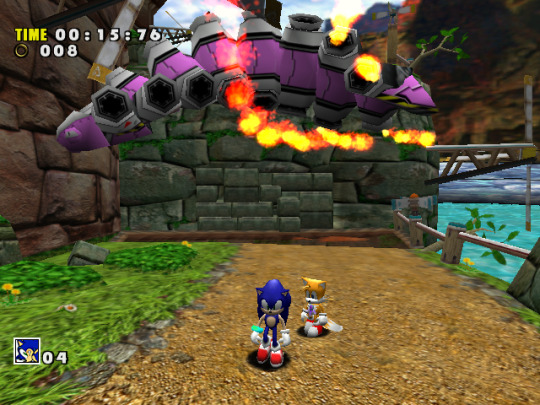
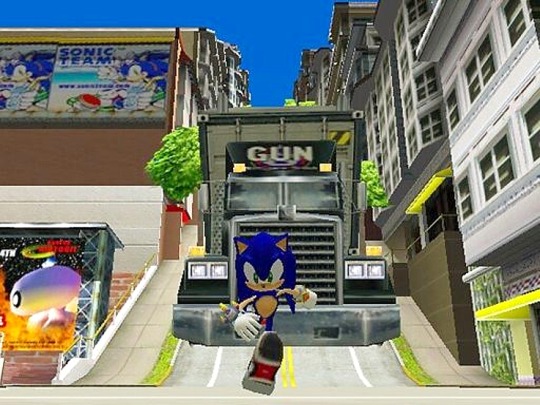
Maybe they haven’t aged as well as I’d like to think, but DAYUM if these weren’t some fun games back in the day. Sonic has always struggled with 3D, but the first attempts at true 3D Sonic games remain quite novel. The first Sonic Adventure had different play styles for each character, some of which were great (Sonic and Gamma, for me at least), others...not so much (the less said about Big, the better), in addition to, for its time, an intricate plot with each character’s story intertwining and playing out differently depending on which character you’re playing as.
Sonic Adventure 2, meanwhile, streamlined the gameplay and improved upon some of the first game’s flaws, cutting out the non-platforming related stages (aside from the treasure hunting stages, which are a touch better than in the first game). It’s story was also very compelling, being one of the darkest storylines in the entire series; government conspiracies, weapons of mass destruction, fucking murder! Maybe that’s not everyone’s cup of tea, but I think we can all agree that SA2 handled “dark and gritty” a lot better than Shadow the Hedgehog’s stand-alone game.
Both games also featured a mini-game that could prove to be just as addicting, if not more so, than the games proper: Chao Gardens. Chao were little, adorable water monsters that players could raise like virtual pets, their popularity likely owed in part to the ubiquity of other virtual pets like Tamagotchi near the end of the millennium, as well as how easy-going and casual raising a Chao was compared to a Digi-Pet that would not wait for you to clean its shit up: you can enter and leave Chao Gardens freely, and you wouldn’t have to worry of your Chao dying of neglect in your absence. There’s also very deep mechanics at work for raising Chao, with their growth and evolution depending heavily on how well you raise them, what animals you give them, and what fruits you feed them, all so you can have them participate in races. The aforementioned VMU also expanded Chao functionality considerably, letting you raise them anywhere you wanted.
Shenmue
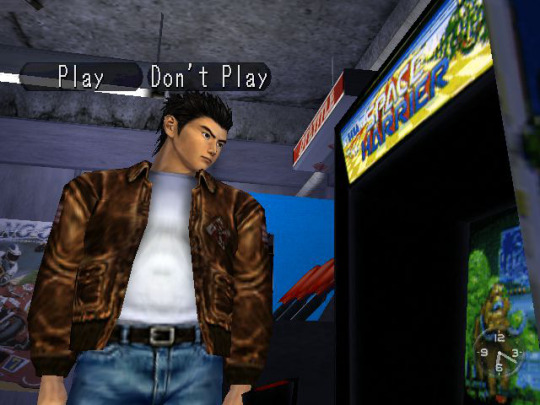
My relationship with Shenmue, these days, is very much that of a love-hate relationship. On the one hand, Shenmue popularized two aspects of gaming today that I loathe; Quick-Time Events, and over-blown game budgets (this game would’ve had to be bought by every DC owner TWICE before it could break even). On the other hand, there’s no denying that this game was a labor of love by Yu Suzuki. The attention to detail in Ryo Hazuki’s hometown of Yokosuka is staggering. Everything you can imagine can be interacted with, down to the last dresser drawer in Ryo’s house. Every resident of Yokosuka was unique from the others and had their own behaviors that they would go through, unlike every other NPC in the town, or other games for that matter. The story may be a tad formulaic, and most of the voice work left something to be desired, but the world of Shenmue was one that was very fun to explore.
Plus, this game introduced me to Space Harrier. If that’s not a good thing, you tell me what is.
Jet Set Radio
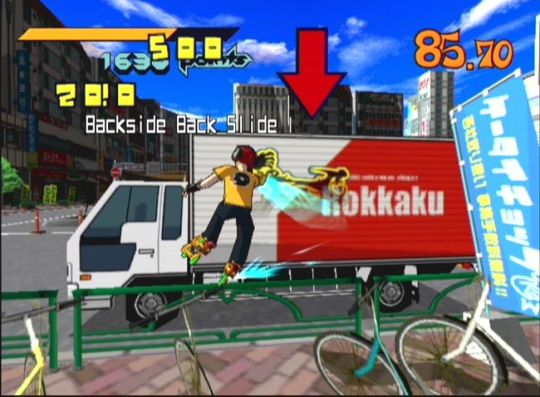
I had to convince my mother this game wouldn’t turn me into a graffiti-painting delinquent. It was a hard sell, but it paid off, and boy am I glad it did.
Jet Set Radio is very much unlike other games, then and today even. This was the game that helped to popularize cel-shaded graphics; the thick black outlines around the character models made this game look like an anime come to life, and eventually paved the way for the wicked-awesome graphics we see today from Arc System Works with Guilty Gear XRD and Dragonball FighterZ. The idea of playing a roller-blading hooligan throwing tags around the city and evading the police was also unique, and kept players on their toes as techno music accompanies their shenanigans. The game was a bit on the short side, but was challenging and fun enough that multiple playthroughs were warranted.
Making my own graffiti tags was also quite the timesink.
Phantasy Star Online
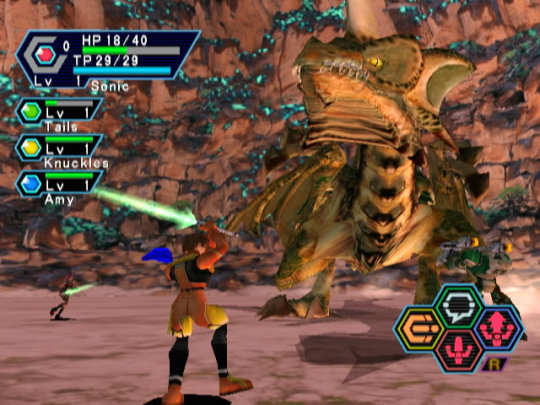
I may be a late bloomer to the Phantasy Star series, but it has become one very dear to me for helping me meet some of my closest friends (Hi, Tara!).
Phantasy Star was a series of JRPGs by Sega meant to compete with other big franchises like Final Fantasy and Dragon Quest. The original PSO, on the other hand, is an online multiplayer dungeon crawler that would change the course of the series from that point forward. As interstellar colonists investigating mysterious phenomena on an alien planet, players would delve into unique locals with characters they would create themselves to slay monsters, collect valuable items, and unravel the mysteries of the planet Ragol.
The original PSO is also very notable for its attempt to break the language barrier with a unique conversation system. While good ol’ fashioned keyboards remained in vogue, players also had the option of constructing sentences to transmit to other players in the area or party in those players’ native languages. Using this system, you could send a message saying “Help! This dragon is too powerful!”, and your friend in Japan would read it as “助けて!この龍は強すぎる!” It may not have seen much use, since players are more likely to congregate and play with those that can speak a common language fluently, but it was very kind of Sega to provide the option.
One thing that gets me straight in the feels is something from the original beta trailer for this game: “The world of Phantasy Star Online lasts for an eternity!” It is not uncommon for trailers and developers to hype games up with hyperbole (just ask Peter Molyneaux), but this is a statement that has held true for PSO! Even after the last official server for the last iteration of PSO shut down in 2008, private servers continue to run the game to this day, ensuring that the world of PSO truly remains eternal. Even with a proper sequel Phantasy Star Online 2 proving to be a pop culture staple in Japan, the original PSO remains one of the most beloved and enduring MMOs in history.
Skies of Arcadia
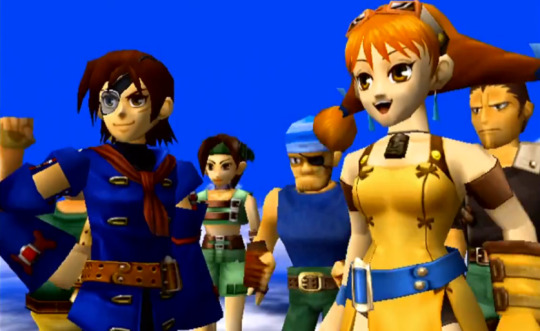
I’ve got friends who would skin my hide and leave me to hang like the Predator if I didn’t mention this.
Just about every console since the NES has a JRPG, and the Dreamcast is no exception. While Phantasy Star shifted towards MMO territory, those hoping for a sweeping single-player adventure still had Skies of Arcadia. As the daring sky pirate Vyse and his motley crew of adventurers, players fought to stop an evil empire from awakening an ancient evil while flying across a world of floating continents in a kickass airship. This game is among the most challenging JRPGs in the genre; a clever mind and strategic acumen are needed to survive battles with other pirates, monsters, and rival airships. The world of the game is also incredibly beautiful; I personally think it has much in common with Castle in the Sky, my favorite Hayao Miyazaki film. The soundtrack compliments the game incredibly, and is a joy to listen to by itself.
---
There are plenty of other games that made the Dreamcast incredible, but this article is long enough as it is, so I’ll have to give those games their proper due later. Suffice to say, though, the Dreamcast is a historical console that remains one of the most beloved in the history of the medium, not only by myself, but by hundreds of thousands of gamers the world over. It may have only been on the market for a few years, but it is said that the brightest stars are the ones that burn out the quickest.
And make no mistake, the Dreamcast is one of the brightest stars there ever was.
234 notes
·
View notes